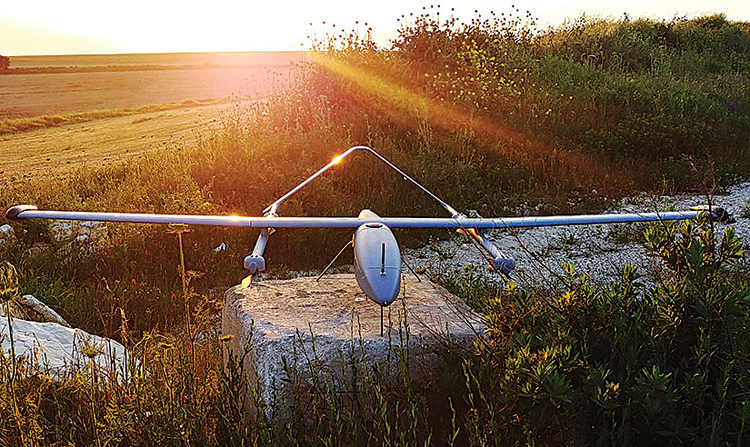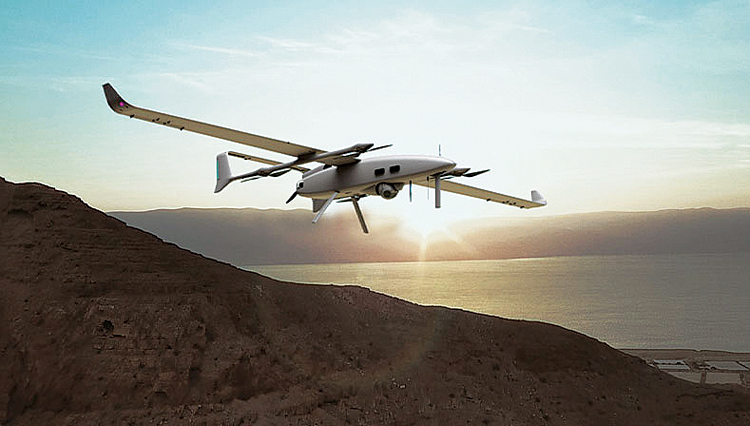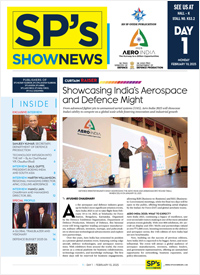- Prime Minister Narendra Modi inaugurates Aero India 2023 in Bengaluru; Releases Commemorative Stamp
- Defence Secretary meets delegations from Saudi Arabia, USA and Oman on the sidelines of Aero India 2023
- Foreign Ministers of 32 countries to attend Aero India 2023
- Embraer showcases the C-390 Millennium at Aero India 2023
VTOL: Transforming Tactical UAS Operations
IAI's newly extended UAS family now offers vast and agile operational capabilities

IAI’s family of VTOL-UAS provide a new, middle tier between the Heron MALE and small, mini-tactical drones. Developed and produced by IAI’s subsidiary BlueBird Aero Systems, the ThunderB and WanderB drones merge the capabilities of small tactical drone and multi-rotor drone, unbound to airfields or complex launch, retrieval and long turnaround cycles. They are optimised for simple use at the low echelon in all terrains, including maritime environment, and provide excellent intelligence products, delivering services that were previously rendered only by large platforms.
INTRODUCING THE VTOL FAMILY
The ThunderB-VTOL and WanderB-VTOL are both hybrid fixed-wing UAVs, offering high operational flexibility and combine the advantages of a fixed-wing UAV with the benefits of a multi-copter. As fixed-wing platforms, they offer Extended endurance, high-speed operation in harsh environments, large area coverage, silent operation, and ability to glide to safe landing. As multi-rotor platforms, they have the ability to take off and perform a soft and accurate landing in small and limited areas, such as on ships in mid-sea, small forest clearings or flat rooftops in urban areas. They can also hover over an area of interest when needed. This is done without the logistical footprint required to support the takeoff and landing of small tactical fixed-wing platforms.
These innovative and versatile systems are designed to conduct covert, realtime, “over-the-hill” or extended range operations, in day-and-night, collecting Intelligence, Surveillance, Target Acquisition and Reconnaissance (ISTAR), provide rapid tactical mapping on demand (TMOD), through GPS marked, High-Definition (HD) photogrammetric video processing.

BLUEBIRD COMPLETES DELIVERY OF 100 VTOL UAVS
BlueBird Aero Systems, partially owned by Israel Aerospace Industries (IAI), completed the delivery of 100 WanderB-VTOL UAVs to a European customer. The Vertical Takeoff and Landing (VTOL) UAVs are part of a transaction involving over 150 WanderB-VTOL and Thunder-BVTOL UAVs worth tens of millions of dollars. This is the world’s largest number of VTOL UAVs delivered to any customer at one time, and was completed within the agreed timetable despite COVID-19 conditions.
The transaction reflects a globally emerging trend of VTOL UAVs, which provide important benefits for land and maritime applications as they combine the advantages of a fixed-wing UAV (long-range, long-endurance, high speed, wind independency, large area coverage, etc) with the advantages of a multicopter (ability to take off and land in confined areas, accurate, safe and damage-free landing, etc). The asset and capability combination of IAI and BlueBird is expected to yield additional breakthrough operational solutions on the market.
VTOL-UAS ADVANTAGES
- Operational Flexibility: Operations in urban areas, forests and jungles and maritime environment often lack adequate areas for the launch and retrieval of drones. In these environments the VTOL-UAS transforms to a large multirotor drone that blends the vertical access and hovering capability with the speed, mission endurance and low signature typical of the fixed-wing, forward flight regime. Add these to low-cost benefits (no runway needed, less crewmembers to operate, and less equipment) and you get a winning solution for tactical military/civil operations.
- Mission Economy: Since each of the flight phases uses a propulsion system optimized for it, the combined propulsion system is energy efficient. The four rotors providing the lift for vertical flight and hover can operate with rotors and RPM optimized for lift, while the forward flight is supported by low-drag and low RPM propellers and motors for higher speed and longer endurance. Designers can choose between electric, hybrid-electric or piston engine motors, to meet the mission requirements with best performance.
- Signature Reduction: Using electrical propulsion, propellers and rotors optimized to perform effectively, reduces the acoustic signature, in addition, comparing to “standard” multicopter, by operating a fixed-wing platform that just vertically takeoff and land, provides an important tactical advantage when operating at low altitude, deep in hostile territory. Reduction of size, compared to large platform, further reduces the platform’s visible and radar signature.
- Speed: Platforms relying on fixed-wing designs can achieve higher cruise and dash speed, gaining transit and cruising speeds dozens of knots faster than multirotor drones designed for equivalent weight and size specifications.
- Payloads: Designed to operate on long missions with large payloads, VTOLUAS are designed around the payload to meet mission requirement with an optimal platform weight and size. With three payload attachment points they can operate a compact radar, EO/IR and SIGINT/COMINT. The payload bays and attachments are designed to open standards, enabling users to add mission payloads from other OEMs, what makes the platform and entire solution as competitive and affordable as possible.
VTOL-UAS become very useful in operations from enclosed space, such as the small decks onboard ships or offshore platforms. Since their flight is more efficient, VTOL-UAS can carry heavier payloads, compared to multi-rotor drones. Such payloads can include small radars, multiple EO/IR gimballed payloads and SIGINT. Performing missions with long-endurance, VTOL-UAS launched and operated from ships at sea can cover wide areas, deep at sea and far from land.
Redundancy: Multi-rotor drones have little redundancy as they need all rotors to generate lift, thus, any failure of a rotor, motor or flight system leads to mission abort, immediate descent and emergency landing or crash. The VTOLUAS has two lift systems that provide redundancy for the critical landing phase. The electric quadrotor generates the lift for the vertical landing, but the drone can also perform landing using parachute, airbag or skid on a flat surface in case of emergency, in case of partial or complete rotor system failure due to mechanical or combat damage.
LEADING THE VTOL GENERATION
With clear and proven benefits to the user, VTOL-UAS have the potential to transform tactical drone operations. The market is converting to the new technology that offers many benefits to the users, as they realised the performance and logistic advantages of this new capability. All branches of the US military are already moving in this direction, as other military forces and commercial users worldwide. BlueBird Aero Systems and IAI are among the few pioneers in this field, who have delivered and fielded systems on a large scale to a number of users. Unlike other manufacturers that rely on third-party systems quadrotor system, the IAI-BlueBird Aero Systems drones use ITAR-free, bespoke VTOL system developed in-house that is optimised for each platform. This new capability offers significant advantage to the user, by reducing the logistic footprint required for operational deployment with tactical forces.





